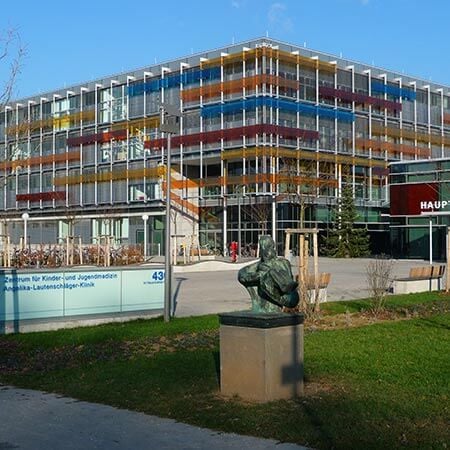A penile fracture is an uncommon injury caused by a rupture of the tunica albuginea. This trauma can only be sustained when the penis is in its erect state. In 60% of cases, such fractures occur during sexual intercourse with a woman on top. If you are injured, you can undergo your treatment in Germany. At a good German hospital, the genital organ will be completely restored while maintaining its aesthetics, erection, and urination functions. On the Booking Health website, you can find out the cost of treatment and choose a medical care program at the best price.
Content
- Causes and mechanisms of the injury
- Penile fracture diagnostics
- Treatment of a fracture of the penis
- Treatment of a urethral injury
- Why to undergo your treatment in Germany?
Causes and mechanisms of the injury
In most Western countries, the main cause of a penile fracture is sexual intercourse. The causes and mechanisms of the injury are, however, not always the same. For example, in Japan, only 19% of fractures of the penis occur during sexual intercourse, and the most common cause of the injury is turning over in bed on an erect penis. In some countries, the most common cause of the injury is considered to be a violent attempt to eliminate an erection by bending the penis.
The literature describes many unusual and even ridiculous situations that ended in a penile fracture, for example, a brick falling on an erect penis, a donkey bite, an unsuccessful movement in tight trousers, and placing the genital organ in a shaker for the purpose of masturbation.
In 96% of cases, a rupture of one cavernous body in the penis occurs. In 4% of cases, the injury is bilateral. As a rule, no more than half of the circumference of the genital organ is involved. For unknown reasons, the right cavernous body is ruptured more often than the left. The rupture of the tunica albuginea has a transverse orientation. Some men have their spongy body and urethra additionally injured.
Penile fracture diagnostics
Patients complain of a sudden onset of pain. In the moment of injury, they hear a cracking sound. They immediately lose their erection, their genital organ swells, and a hematoma develops.
The intensity of the pain varies greatly from patient to patient. Many men suffer from a mild pain syndrome, which gives a false impression that the injury was minor.
The diagnosis can be established by a doctor during an examination. The classic sign is the "eggplant deformity" of the penis, as it is the same blue color (due to a hematoma) and curved (due to a fracture). The deviation occurs in the opposite direction from the injury.
In some cases, doctors can detect a ruptured area of the tunica albuginea with palpation.
Hematuria (the presence of blood in a person's urine) and urinary retention are symptoms for which a concomitant urethral rupture should be suspected. This type of injury is more commonly found in patients suffering from hematuria, while urinary disorders can be associated with a curvature of the penis and an accumulation of blood in the tissues near the urethra. Urethral ruptures are more common in patients with bilateral trauma, when both cavernous bodies of the male genital organ are damaged.
An ultrasound scan is not a mandatory method for confirming the diagnosis, although it can be used in doubtful cases. Occasionally, doctors may resort to an MRI scan. If a rupture of the urethra is suspected, urethrography (an X-ray scan with contrast enhancement) can be performed.
Among non-invasive tests, an MRI scan is the most informative for assessing the severity and nature of the injury. It is done at German hospitals if doctors are not sure about the presence of a fracture, as well as when they are planning surgery, in order to select the optimal surgical approach.
Treatment of a fracture of the penis
An operation to treat a penile injury should be performed as soon as possible after the injury, ideally on the first day. From day 2 and later, the aesthetic and functional outcomes of the treatment of the disease worsen.
There are no hard tissues, including bones, in the male genital organ. Therefore, a fracture is essentially a rupture. Thus, the basis of treatment is its suturing.
Surgery for the treatment of a fracture of the penis differs in the type of surgical approach. Doctors can perform surgical interventions through the following approaches:
- a small incision in the ruptured area (this is the least traumatic option that is not suitable for penile injuries with associated urethral ruptures);
- a circular subcoronary incision with an indent of 1 cm from the coronary sulcus is a more traumatic operation that allows access to all tissues of the penis and urethra;
- an inguinoscrotal approach that provides access to any tissues without any loss of sensitivity of the penis.
The task of surgical treatment is not only the restoration of the integrity of the male genital organ but also the achievement of satisfactory aesthetics for the penis, the preservation of erection, sensitivity, and a high quality of sexual life. Taking the concomitant urethral rupture into account, it is also important to preserve the function of urination, avoid the formation of strictures (cicatricial narrowing), shortening of the urethra with penis deformity, and the development of other complications.
During surgical treatment, a doctor makes a skin incision, dissects soft tissues, and opens Buck's fascia. The blood is then evacuated, since a hematoma always forms due to a penile fracture. The doctor conducts a thorough revision of the tissues and assesses damage to the tunica albuginea. In the process of treatment, urologists abroad use a dye that is injected into the cavernous bodies to determine the ruptured areas, if they are invisible, and to identify minor injuries that also need to be sutured. After suturing, the quality of the sutures is checked by an intracavernous administration of saline. The saline solution mimics an erection and should not leak from the area of the fracture where the doctor has applied sutures. It is not necessary to remove them after the completion of treatment. Biodegradable sutures are usually used for penile fractures. Over time, they dissolve on their own.
Sometimes a penile injury is accompanied by a significant skin defect. In this case, it can be repaired with the help of plastic surgery. Doctors use a microsurgical technique to transfer the flap from another part of the body and close the defect. Surgical treatment in Germany provides excellent aesthetic results. There are no noticeable scars on the penis that would cause a patient any psychological or physical discomfort. After the completion of treatment in Germany, a man can lead a full-fledged sexual life that does not differ in quality from the preoperative level.
Treatment of a urethral injury
According to various authors and members of the European Association of Urology, from 6 to 9% of cases of penile fractures are accompanied by urethral trauma. The rupture of this organ can be complete if it penetrates all layers of the urethral wall, or partial if some layers remain intact. By their location, the ruptures can be classified as transverse or longitudinal. A complete transverse rupture disrupts the continuity of the urethra.
Urethral injuries do not necessarily require an additional stage of surgery to restore them. If the rupture is partial and has a small extent, the urethra can recover on its own after conservative treatment. A catheter is implanted in a patient for 10 days to create favorable conditions for the restoration of the organ and ensure urine outflow.
A complete or extended rupture requires an additional urethral intervention. In such cases, surgical treatment in Germany is supplemented by the following stages of the operation:
Primary urethral suture. This is the most common treatment option. Doctors suture defects, thereby restoring the integrity of the organ. The wall then grows together, and the sutures will dissolve over time.
Urethral anastomosis. If a patient has a transverse rupture, doctors will connect the ends of the urethra and suture them together to restore the continuity of the organ.
Urethral resection. When a man has severe injuries to the organ, a urologist can remove the part of it that cannot be restored. The ends will then be sutured if the remaining length of the urethra is sufficient.
Urethral reconstruction. If a significant portion of the urethra must be removed during treatment, pulling the ends together and suturing them will result in penis deformation. To avoid such consequences, urologists in Germany reconstruct the organ. They recreate the lost part of the urethra from other tissues, such as the skin of the scrotum, penis, inner thigh, or buccal mucosa.
Urethral surgery is complex and not equally successful everywhere. A doctor must not only restore this organ but also completely normalize its blood supply. Otherwise, serious complications may develop in the postoperative period. These may include urethral tissue necrosis with the formation of fistulas and strictures, as well as penis deformation. Surgeons in Germany use microsurgical techniques to restore blood supply and innervation to all tissues, so complications are rare at Urology Centers in Germany.
Why to undergo your treatment in Germany?
Patients from countries with a low level of medicine often visit German hospitals to undergo their treatment for diseases of the urinary system. If you have a penile injury, you can receive medical help at one of the urology hospitals in Germany. The Booking Health website lists the best medical centers and specifies the real cost of treatment where you can make an appointment for your treatment in Germany.
There are a few reasons for you to get medical help at a German hospital. These are the following:
- modern departments equipped with the latest technology;
- accurate diagnostics allow for the assessment of all penile and urethral injuries to optimally plan surgical treatment;
- intraoperative diagnostics help find all the ruptures, even the smallest ones, close them with sutures, and check the tightness of the sutures;
- skin plastic surgery can be performed to achieve a good aesthetic result, if required;
- doctors who are members of different urologic associations perform even the most complex urethral surgery, including resection with the following reconstruction with autologous tissues;
- a low risk of complications;
- preservation of erectile function;
- preservation of the normal shape of the penis;
- full rehabilitation after surgery;
- normal urinary function;
- a well-performed urethral intervention contributes to a low probability of developing problems with urination in the future.
You are welcome to use the Booking Health service to find out the cost of treatment at different German hospitals and undergo your treatment in Germany at the best price. We will help you choose a German hospital that specializes in urologic surgery and achieves the best results in the restoration of the penis and urethra. The specialists at the Booking Health company will take care of the arrangement of your urgent treatment in Germany, because the timing of receiving medical care for a penile fracture is the main thing that will help doctors eliminate all the consequences of this injury.
When you make your treatment appointment through Booking Health, the cost of treatment will be lower than usual. Prices will be reduced due to the absence of taxes for foreign patients at German hospitals. Our specialists will organize your treatment in Germany, help you collect the necessary documents, and book hotel and airline tickets. They will also meet you at the airport and take you to the hospital by car. After the completion of your treatment program, our specialists will take care of your return transfer to your home country.
Authors:
The article was edited by medical experts, board-certified doctors Dr. Nadezhda Ivanisova and Dr. Vadim Zhiliuk. For the treatment of the conditions referred to in the article, you must consult a doctor; the information in the article is not intended for self-medication!
Sources:
Medscape
PubMed
Healthline




















